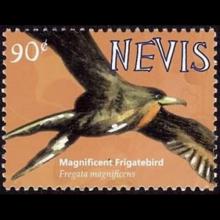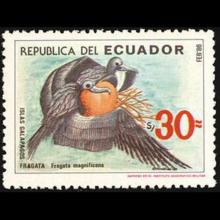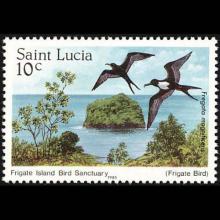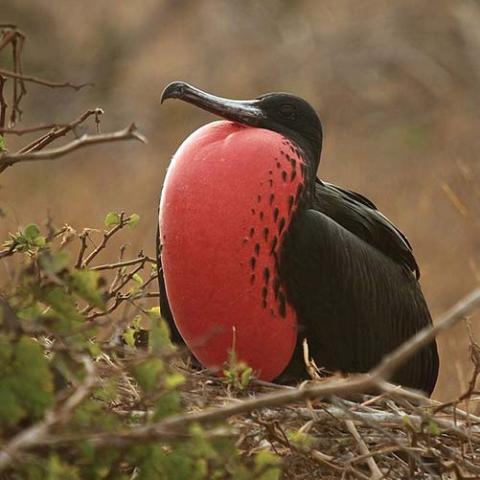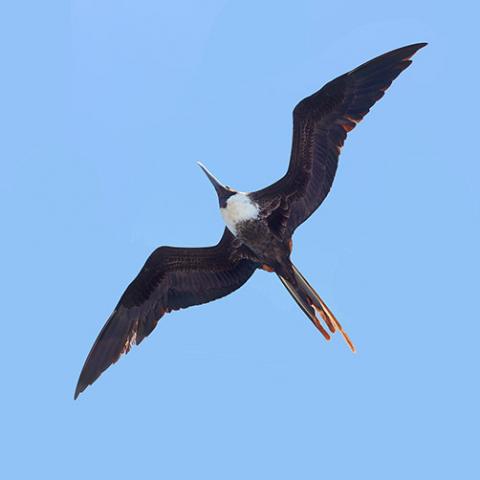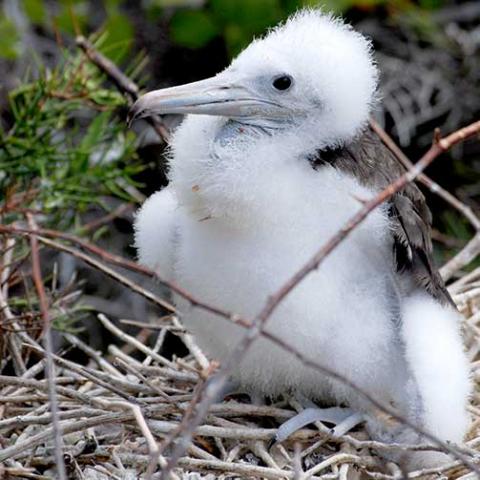NAMES
TAXONOMY
Nevis
Issued:
Stamp:
Fregata magnificens
Ecuador
Issued:
Stamp:
Fregata magnificens
Saint Lucia
Issued:
Stamp:
Fregata magnificens
Nevis
Issued:
Stamp:
Fregata magnificens
Ecuador
Issued:
Stamp:
Fregata magnificens
Saint Lucia
Issued:
Stamp:
Fregata magnificens
Nevis
Issued:
Stamp:
Fregata magnificens
Ecuador
Issued:
Stamp:
Fregata magnificens
Saint Lucia
Issued:
Stamp:
Fregata magnificens
Cool Facts
- Frigatebirds are the only seabirds in which the male and female look strikingly different. Females may not have the males' bright red pouch, but they are bigger than males.
- The breeding period of the Magnificent Frigatebird is exceptionally long. Males and females incubate the eggs for around 56 days, and once hatched, chicks don't leave the nest until they are about 167 days old. Even after they leave the nest, females continue to feed them until they are one year old.
- The Magnificent Frigatebird spends most of its life flying effortlessly over the ocean. It rarely lands on the water even though it has webbed feet, because unlike other seabirds it lacks waterproof feathers.
- The frigatebird is sometimes called the "man-o-war bird" because it harasses other birds until they regurgitate recently captured food, which the frigatebird snatches in midair.
- Learning how to chase other birds and steal meals takes practice. Young frigatebirds hold sticks in their mouths and chase each other. When one of them drops the stick, the other dives below to retrieve it.
- The oldest known Magnificent Frigatebird was at least 19 years, 9 months old when it was recaptured and rereleased in the Lesser Antilles during a scientific study.
Reference: www.allaboutbirds.org
Link to recordings of: Fregata magnificens (Magnificent frigatebird)
Genus species (Animalia): Fregata magnificens
The magnificent frigatebird (Fregata magnificens) or man o' war is a seabird of the frigatebird family Fregatidae. With a length of 89–114 centimetres (35–45 in) and wingspan of 2.17–2.44 m (7.1–8.0 ft) it is the largest species of frigatebird. It occurs over tropical and subtropical waters off America, between northern Mexico and Perú on the Pacific coast and between Florida and southern Brazil along the Atlantic coast. There are also populations on the Galápagos Islands in the Pacific and the Cape Verde islands in the Atlantic.
The magnificent frigatebird is a large, lightly built seabird with brownish-black plumage, long narrow wings and a deeply forked tail. The male has a striking red gular sac which he inflates to attract a mate. The female is slightly larger than the male and has a white breast and belly. Frigatebirds feed on fish taken in flight from the ocean's surface (often flying fish), and sometimes indulge in kleptoparasitism, harassing other birds to force them to regurgitate their food.
History and etymology
encountered magnificent frigatebirds when passing the Cape Verde Islands on his first voyage across the Atlantic in 1492. His journal for the voyage survives in a version made in the 1530s by Bartolomé de las Casas. The entry for 29 September reads in English:
They saw a bird that is called a frigatebird, which makes the boobies throw up what they eat in order to eat it herself, and she does not sustain herself on anything else. It is a seabird, but does not alight on the sea nor depart from land 20 leagues. There are many of these on the islands of Cape Verde.
In the 15th century text the name of the bird is written as rabiforçado. The modern Spanish word for a frigatebird is rabihorcado or "forked tail". A population of magnificent frigatebirds once bred on the Cape Verde Islands but is now probably extinct.
The word frigatebird derives from the French mariners' name for the bird La Frégate - a frigate or fast warship. The etymology of the name was given by French naturalist Jean-Baptiste du Tertre when describing the magnificent frigatebird in 1667. English mariners referred to frigatebirds as Man-of-War birds. This name was used by the English explorer William Dampier in his book An Account of a New Voyage Around the World published in 1697:
The Man-of-War (as it is called by the English) is about the bigness of a Kite, and in shape like it, but black; and the neck is red. It lives on Fish yet never lights on the water, but soars aloft like a Kite, and when it sees its prey, it flys down head foremost to the Waters edge, very swiftly takes its prey out of the Sea with his Bill, and immediately mounts again as swiftly; never touching the Water with his Bill. His Wings are very long; his feet are like other Land-fowl, and he builds on Trees, where he finds any; but where they are wanting on the ground.
The modern name Frigate Bird was used in 1738 by the English naturalist and illustrator Eleazar Albin in his A Natural History of the Birds. The book included an illustration of the male bird showing the red gular pouch. Like the genus name, the English term is derived from the French mariners' name for the bird la frégate—a frigate or fast warship.
The genus name, Fregata has the same source as the English term, and magnificens is Latin for "splendidly", from magnificus, "grand".
Taxonomy
The magnificent frigatebird was originally considered to belong to the species Fregata aquila but in 1914 the Australian ornithologist Gregory Mathews proposed that the magnificent frigatebird should be considered as a separate species with the binomial name Fregata magnificens. Of the four other species within the genus Fregata, genetic analysis has shown that the magnificent frigatebird is most closely related to the Ascension frigatebird (Fregata aquila).
Distribution
The magnificent frigatebird is widespread in the tropical Atlantic, breeding colonially in trees in Florida, the Caribbean and also along the Pacific coast of the Americas from Mexico to Ecuador, including the Galápagos Islands.
It has occurred as a vagrant as far from its normal range as the Isle of Man, Denmark, Spain, England, Nova Scotia, the Magdalen Islands, and British Columbia.
Description
The magnificent frigatebird is the largest species of frigatebird. It measures 89–114 cm (35–45 in) in length, has a wingspan of 2.17–2.44 m (7.1–8.0 ft) and weighs 1.1–1.59 kilograms (2.4–3.5 lb). Males are all-black with a scarlet throat pouch that is inflated like a balloon in the breeding season. Although the feathers are black, the scapular feathers produce a purple iridescence when they reflect sunlight, in contrast to the male great frigatebird's green sheen. Females are black but have a white breast and lower neck sides, a brown band on the wings, and a blue eye-ring that is diagnostic of the female of the species. Immature birds have a white head and underparts.
This species is very similar to the other frigatebirds and is similarly sized to all but the lesser frigatebird. However, it lacks a white axillary spur, and juveniles show a distinctive diamond-shaped belly patch. The magnificent frigatebird is silent in flight, but makes various rattling sounds at its nest.
It spends days and nights on the wing, with an average ground speed of 10 km/h (6.2 mph), covering up to 223 km (139 mi) before landing. They alternately climb in thermals, to altitudes occasionally as high as 2,500 m (8,200 ft), and descend to near the sea surface. The only other bird known to spend days and nights on the wing is the common swift.
Conservation Status
The Galápagos population of the magnificent frigatebird may warrant a separate conservation status. This small population of genetically unique magnificent frigatebirds is vulnerable. Any catastrophic event or threats by humans could wipe out the population of approximate two-thousand magnificent frigatebirds that nest on the Galápagos Islands. Magnificent frigatebirds are currently classified as of Least Concern by the International Union for Conservation of Nature, but because of the genetic uniqueness of those on the Galápagos Islands this may need to be revisited.
This population on Cape Verde is thought to be extremely low and on the brink of extinction, despite the original sighting of this species by Columbus likely being that of the Cape Verde population. Protection of the frigatebird's breeding sites is necessary for the species' recovery.
Reference: Wikipedia
Photos: Andrew Turner, Snowmanradio, Benjamint444

